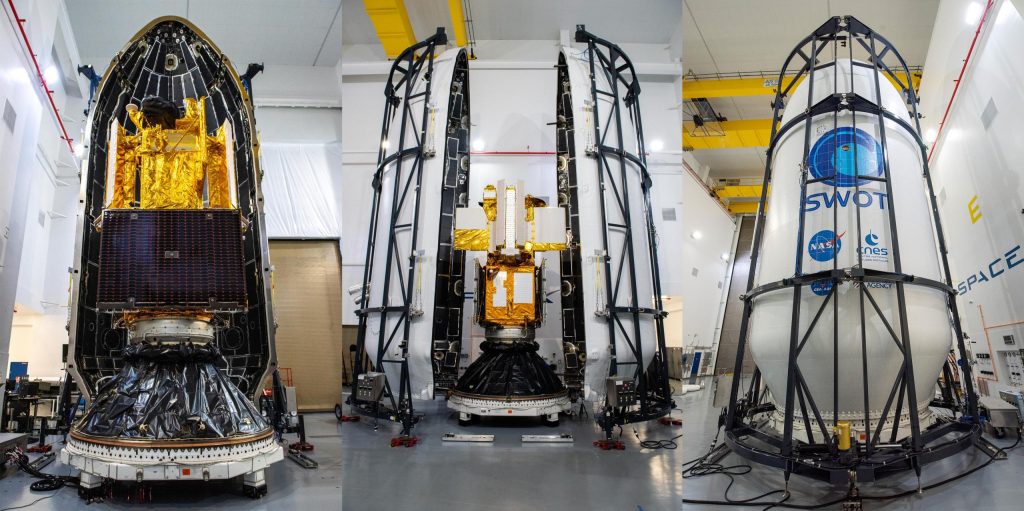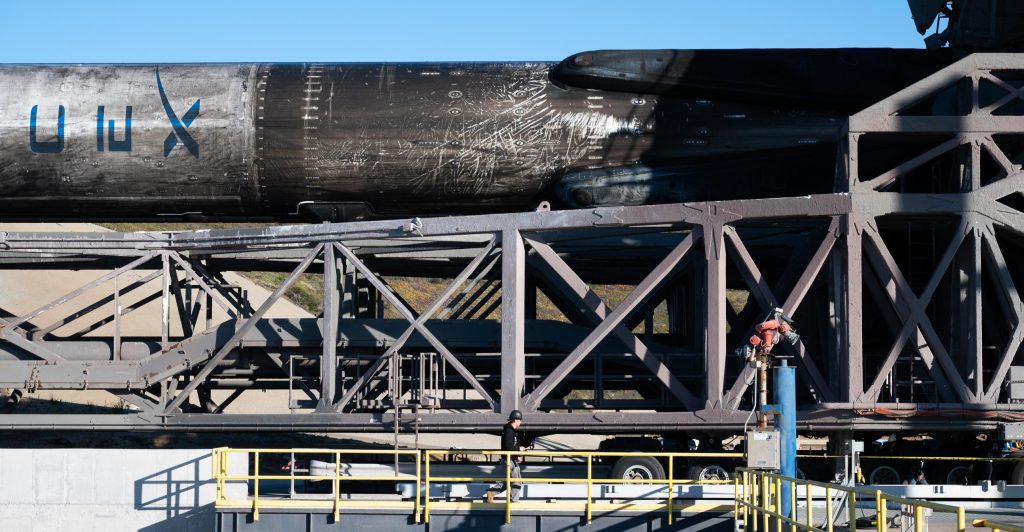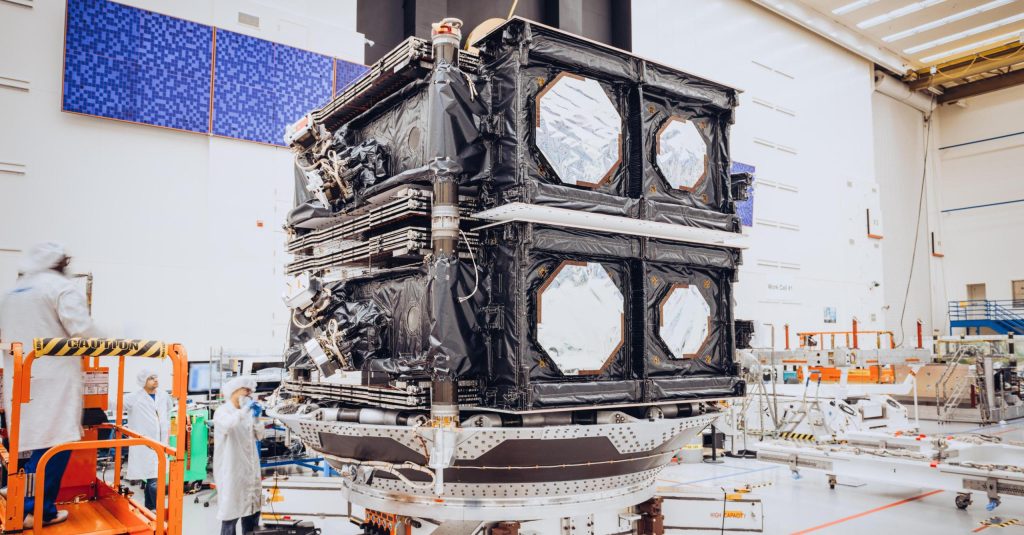SpaceX is in the final stages of preparing a trio of Falcon 9 rockets for a set of launches scheduled less than two days apart.
The potential hat trick will likely be the last opportunity for a salvo of Falcon launches before the end of 2022. As a disclaimer, while unofficial launch dates (derived from regulatory documents or well-sourced public manifests) were consistently close to actual launch dates for most of 2022, that ceased to be the case when SpaceX began experiencing an abrupt uptick in launch delays over the last two months. As a result, Falcon launch dates – even once confirmed by SpaceX – should be assumed to be a bit more uncertain than usual until it’s clear that that trend has died down.
Nonetheless, all available signs indicate that SpaceX and its customers are moving forward with plans for three back-to-back launches before the end of the week.
The update that's rolling out to the fleet makes full use of the front and rear steering travel to minimize turning circle. In this case a reduction of 1.6 feet just over the air— Wes (@wmorrill3) April 16, 2024
Set to kick off the diverse trio is the Surface Water and Ocean Topography (SWOT) spacecraft, a roughly $1.2 billion joint mission between NASA and French space agency CNES. Thanks in part to the COVID pandemic, which has and continues to impact large swaths of NASA and the aerospace industry, NASA’s Jet Propulsion Laboratory completed its portion of SWOT around 9% over budget and eight months behind schedule [PDF] since mission formulation began in 2012. Over a similar time scale, several other NASA missions have experienced cost increases of 10-100%, generally reflecting well on SWOT’s management.
SWOT, a roughly two-ton (~4400 lb) satellite, is designed to conduct the first global survey of all surface water on Earth using two large synthetic aperture radar (SAR) antennas and a conventional radar altimeter. At a cost of roughly $112 million, a SpaceX Falcon 9 rocket is scheduled to launch SWOT to low Earth orbit (LEO) no earlier than (NET) 3:46 am PST (11:46 UTC) on Thursday, December 15th. SpaceX successfully tested SWOT’s Falcon 9 well in advance on December 10th. The rocket was then returned to the company’s hangar at Vandenberg Space Force Base (VSFB) Space Launch Complex 4E for payload installation before rolling back to the pad on December 13th.
The light satellite and low target orbit will allow Falcon 9’s booster to return to the launch site and land at SpaceX’s LZ-4 landing zone, precluding the need for a drone ship recovery.


Up next, another Falcon 9 rocket is scheduled to launch the first two of eleven Boeing-built O3b mPOWER communication satellites for operator SES as early as 4:21 pm EST (21:21 UTC), Friday, December 16th. After lifting off from SpaceX’s Cape Canaveral Space Force Station (CCSFS) LC-40 pad, Falcon 9 is set to launch the roughly 3.4-ton (~7500 lb) pair of satellites to a medium Earth orbit (MEO) with an altitude of 7825 kilometers (4862 mi).
It’s unclear what orbit Falcon 9 will launch the satellites to, but the rocket’s booster will land on drone ship A Shortfall of Gravitas (ASOG) some 700 kilometers (~435 mi) downrange, indicating that it will need as much performance as the rocket can give. ASOG departed Port Canaveral on December 11th, confirming that launch preparations are well underway.

Finally, a third Falcon 9 rocket could launch SpaceX’s first Starlink mission since October 28th as early as 4:54 or 5:13 pm EST (21:54 or 22:13) on December 16th, potentially just 33 or 52 minutes after O3b mPOWER 1&2. If the two missions do launch on December 16th, which a reliable source of unofficial information has indicated is not guaranteed, it will smash the US record for back-to-back launches of the same rocket family. Russia’s R-7 rocket family will retain the international crown, however, having launched twice in 25 minutes in 1969.
Starlink 4-37 will lift off from SpaceX’s NASA Kennedy Space Center LC-39A pad, and its Falcon 9 booster will attempt to launch on drone ship Just Read The Instructions (JRTI). JRTI departed Port Canaveral on December 12th.
Following Starlink 4-37, SpaceX has at least two more launches tentatively scheduled before the end of 2022. NextSpaceflight.com reports that SpaceX could launch its sixth Transporter rideshare mission from Florida on December 27th, and two Israeli EROS-C3 Earth observation satellites out of California on December 29th. However, it’s worth noting that in the almost 17-year history of SpaceX Falcon operations, the company has never launched a rocket after December 23rd or before January 6th. Transporter-6 and EROS-C3 – SpaceX’s 60th and 61st launches of the year – would have to break through that apparent firewall to launch when they are currently scheduled.

News
Waymo scrutinized after self-driving taxis cause traffic jams during SF blackout
It’s not farfetched to speculate that it would have been a doomsday scenario for Tesla had FSD behaved this way.

A power outage across San Francisco over the weekend forced numerous Waymo self-driving taxis to stop at darkened intersections and cause traffic blockages in multiple locations across the city. The disruption left riders stranded, frustrated drivers blocked, and city officials stepping in as the Alphabet-owned company temporarily suspended service amid the widespread gridlock.
Needless to say, it would likely have been a doomsday scenario for Tesla had FSD behaved in a similar way, especially if fleets of its robotaxis blocked traffic for numerous drivers.
Power outage halts Waymo fleet
The outage knocked out electricity for tens of thousands of customers, leaving traffic signals dark across large parts of the city, as noted in a report from the New York Times. Waymo vehicles began stopping at intersections and remained stationary for extended periods, seemingly unable to operate. Tow truck operators worked through the night removing immobilized vehicles, while videos circulated online showing Waymos with hazard lights flashing as traffic backed up around them.
Waymo later confirmed that it had paused its Bay Area ride-hailing service after the San Francisco mayor’s office contacted the company about the congestion its vehicles were contributing to. Service began coming back online shortly after 3:30 p.m. local time, though some users still reported being unable to request rides. Waymo maintained that no injuries or accidents were reported during the outage.
Autonomous cars during emergencies
The incident surprised industry observers since autonomous vehicles are designed to function during signal outages and temporary connectivity losses. Waymo stated that its vehicles treat nonfunctional signals as four-way stops, but “the sheer scale of the outage led to instances where vehicles remained stationary longer than usual to confirm the state of the affected intersections. This contributed to traffic friction during the height of the congestion.” Experts suggested the problem may have been linked to the vehicles’ reliance on remote assistance teams, which help resolve complex situations the cars cannot handle independently.
“Yesterday’s power outage was a widespread event that caused gridlock across San Francisco, with non-functioning traffic signals and transit disruptions. While the failure of the utility infrastructure was significant, we are committed to ensuring our technology adjusts to traffic flow during such events,” the Waymo spokesperson stated, adding that it is “focused on rapidly integrating the lessons learned from this event, and are committed to earning and maintaining the trust of the communities we serve every day.”
News
Tesla aims to combat common Full Self-Driving problem with new patent
Tesla writes in the patent that its autonomous and semi-autonomous vehicles are heavily reliant on camera systems to navigate and interact with their environment.

Tesla is aiming to combat a common Full Self-Driving problem with a new patent.
One issue with Tesla’s vision-based approach is that sunlight glare can become a troublesome element of everyday travel. Full Self-Driving is certainly an amazing technology, but there are still things Tesla is aiming to figure out with its development.
Unfortunately, it is extremely difficult to get around this issue, and even humans need ways to combat it when they’re driving, as we commonly use sunglasses or sun visors to give us better visibility.
Cameras obviously do not have these ways to fight sunglare, but a new patent Tesla recently had published aims to fight this through a “glare shield.”
Tesla writes in the patent that its autonomous and semi-autonomous vehicles are heavily reliant on camera systems to navigate and interact with their environment.

The ability to see surroundings is crucial for accurate performance, and glare is one element of interference that has yet to be confronted.
Tesla described the patent, which will utilize “a textured surface composed of an array of micro-cones, or cone-shaped formations, which serve to scatter incident light in various directions, thereby reducing glare and improving camera vision.”

The patent was first spotted by Not a Tesla App.
The design of the micro-cones is the first element of the puzzle to fight the excess glare. The patent says they are “optimized in size, angle, and orientation to minimize Total Hemispherical Reflectance (THR) and reflection penalty, enhancing the camera’s ability to accurately interpret visual data.”
Additionally, there is an electromechanical system for dynamic orientation adjustment, which will allow the micro-cones to move based on the angle of external light sources.
This is not the only thing Tesla is mulling to resolve issues with sunlight glare, as it has also worked on two other ways to combat the problem. One thing the company has discussed is a direct photon count.
CEO Elon Musk said during the Q2 Earnings Call:
“We use an approach which is direct photon count. When you see a processed image, so the image that goes from the sort of photon counter — the silicon photon counter — that then goes through a digital signal processor or image signal processor, that’s normally what happens. And then the image that you see looks all washed out, because if you point the camera at the sun, the post-processing of the photon counting washes things out.”
Future Hardware iterations, like Hardware 5 and Hardware 6, could also integrate better solutions for the sunglare issue, such as neutral density filters or heated lenses, aiming to solve glare more effectively.
Elon Musk
Delaware Supreme Court reinstates Elon Musk’s 2018 Tesla CEO pay package
The unanimous decision criticized the prior total rescission as “improper and inequitable,” arguing that it left Musk uncompensated for six years of transformative leadership at Tesla.

The Delaware Supreme Court has overturned a lower court ruling, reinstating Elon Musk’s 2018 compensation package originally valued at $56 billion but now worth approximately $139 billion due to Tesla’s soaring stock price.
The unanimous decision criticized the prior total rescission as “improper and inequitable,” arguing that it left Musk uncompensated for six years of transformative leadership at Tesla. Musk quickly celebrated the outcome on X, stating that he felt “vindicated.” He also shared his gratitude to TSLA shareholders.
Delaware Supreme Court makes a decision
In a 49-page ruling Friday, the Delaware Supreme Court reversed Chancellor Kathaleen McCormick’s 2024 decision that voided the 2018 package over alleged board conflicts and inadequate shareholder disclosures. The high court acknowledged varying views on liability but agreed rescission was excessive, stating it “leaves Musk uncompensated for his time and efforts over a period of six years.”
The 2018 plan granted Musk options on about 304 million shares upon hitting aggressive milestones, all of which were achieved ahead of time. Shareholders overwhelmingly approved it initially in 2018 and ratified it once again in 2024 after the Delaware lower court struck it down. The case against Musk’s 2018 pay package was filed by plaintiff Richard Tornetta, who held just nine shares when the compensation plan was approved.
A hard-fought victory
As noted in a Reuters report, Tesla’s win avoids a potential $26 billion earnings hit from replacing the award at current prices. Tesla, now Texas-incorporated, had hedged with interim plans, including a November 2025 shareholder-approved package potentially worth $878 billion tied to Robotaxi and Optimus goals and other extremely aggressive operational milestones.
The saga surrounding Elon Musk’s 2018 pay package ultimately damaged Delaware’s corporate appeal, prompting a number of high-profile firms, such as Dropbox, Roblox, Trade Desk, and Coinbase, to follow Tesla’s exodus out of the state. What added more fuel to the issue was the fact that Tornetta’s legal team, following the lower court’s 2024 decision, demanded a fee request of more than $5.1 billion worth of TSLA stock, which was equal to an hourly rate of over $200,000.
Delaware Supreme Court Elon Musk 2018 Pay Package by Simon Alvarez










